Post-colonial criticism and reflection ran like a thread through this year's Holland Festival programme. Not only William Kentrigde and Faustin Linyekula, the associate artists with whom the festival's programmers collaborated, address the devastating effects of centuries of Western European trade and commerce with their work. In the reframe of political and social history and reclaiming dignity, intimate experiences and personal stories play an important role.
Pamphlets
Some performances were unusually direct in the way they called attention to racism and sexism, and its roots in European heritage. The most unadulterated (from what I saw) was Marco Layera's performance, Paisajes para no colorear (Not colourable landscapes).

Nine Chilean teenage girls describe the daily dose of sexist shit they get thrown at them as they grow up. The performers' open-mindedness gives the performance an absurd depth. A beautiful scene occurs when the girls ask a man from the audience to join them on stage at Amsterdam's Stadsschouwburg theatre.
Hidden behind a newspaper, he overhears a young actress. With a heartbreaking enumeration of grievances, she accuses her father of not paying any attention and not showing a shred of respect to her mother. Only to throw herself on his lap, begging for attention and love. It obviously falls on deaf ears. Whether the man understands Spanish or not, his face remains hidden behind the newspaper and he does not move a single fin. The incarnate blindness and emptiness of patriarchy briefly - and with verve - creeps onto the stage.
Schematic
The show is structured as a doctrinal piece. Successive scenes give different examples each time of the consistent misogyny that appears to afflict today's Chile like an epidemic. But many scenes in Paisajes para no colorear are rather predictable. I can imagine the play provoking a lot of discussion, but as theatre, it is very schematic.
The girls remain figments and my extremely limited picture of Chile is at best confirmed in negative terms. The ongoing effects of colonisation and Catholic mission in Chile are presented as a fait accompli. The global sexy-rebellious-internet-girl culture does bring some complexity into play, but through it I search in vain for something, to which I could attach myself beyond the immense cliché of that damn patriarchy.

Other people's backyard
A similar reproach could be levelled at French director Philippe Quesne. His beautifully polluted, dystopian view of tropical island with partying Robinson Crusoe-impersonators did not bring much news either. The destructive foolhardiness of international tourism is an eyesore for many, but who is going to curb this global economy?

Crashpark - la vie d'une île then at least raised a question, as I here wrote. The performance painfully depicts the status quo precisely by omitting protesting protagonists. Quesne deploys theatre, with its ability to turn it into a life-size, scenic viewing box, to confront spectators with the interconnectedness of a number of issues, where neo-colonial relations and economic growth are allowed to take place at the expense of everything we hold dear, as long as it takes place in someone else's backyard and not in ours. That, as a result, we still cannot consider the well-being of the world as a whole is highlighted in the finale with Sinatra's triumphant Fly me to the moon painfully underlined.
That I appreciate the two performances so differently, even though they are in fact a similar indictment of a doomed status quo, has of course everything to do with my position as a Dutch spectator. The struggle in Chile remains distant, while Quesne's perspective is in line with my everyday experience. It is precisely these kinds of differences in perspective and approach, sometimes difficult to bridge, that made this year's festival programme so valuable and exciting.
Locked-up masculinity
Racism was also a frequent topic. Award-winning French rapper Abd Al Malik was invited by the Holland Festival to present his concert cum dance performance Le jeune noir à l'épée show. It became a somewhat strange gathering, with Malik and brothers Arnaud and Fayette Fayette Mikano, combining cool, stiff beats with raunchy and poetic lyrics, while four extra-muscular break dancers did choreography by Salia Sanou.
The above trailer gives a good idea of what the show could have done, because of the complicating combination of Malik's text, on rêve de musée mais pas d'être musifié, the dancing of Sanou and the painting Le jeune noir à l'épée, from the Paris Musée d'Orsay (the work's original patron, due to a exhibition on the representation of black people in French painting). But instead it became a wondrous show of trapped, black masculinity.

Distorted self-image
Of course, it didn't help that hip-hop or even pop audiences were missing from the Muziekgebouw, but there was very little contact with the audience, and the choreography also kept the men trapped in a closed macho repertoire. There were wonderful songs that stayed with us because of their radiant directness, such as eux, or the mean swinging and super poetic Gibraltar, in which a young man makes the reverse crossing.
Several songs deal with the link between racism and tough insistence and the distorted self-image that results. But as clear and sharp as the lyrics are, the direction is vague in defining a relationship or creating dynamics between the different registers. Mandatory masculinity is neither dismantled nor deferred, by anything of a personal or intimate gesture. Theatre failed to hurl the destructive, racist clichés out of their orbit.
Black role model
The latter did succeed in Not Another Diva (2018), one of four projects Congolese dancer and choreographer Faustin Linyekula showed in this festival. Together with South African singer and theatre-maker Hlengiwe Lushaba, Linyekula staged a subtly out-of-place, theatrical chamber concert.
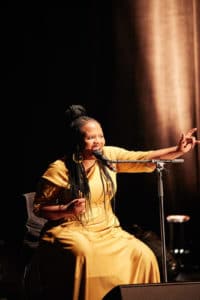
Lushaba, who has worked with Linyekula more often, wanted to join Studios Kabako recording a new CD in Kisangani, without the pressure of commercial producers. This fact was developed into a broader sense of having to be available to everything and everyone. Not Another Diva refers to the toll that black singers and other role models pay for having a voice and fulfilling a political role, think of Miriam Makeba, Busi Mhlongo or Nina Simone.
Woman central
The performance is cunningly constructed. Spectators and band share the floor around an empty centre. The hall of the Muziekgebouw has been emptied and there are loose chairs and tables. There is a bar. The performers, too, each have their own chair. At first, the songs followed each other in Zulu, while intertitles give only hints: how to warm up the soul, mama says breath, the uncles-song, choice is mine. Not everything needs to be translated into English. Transparency or translatability of every syllable to western perspective is deliberately abandoned. The men wear caps and hats, so their faces are barely in view. And even otherwise, unless with their brilliant playing, the male musicians (Franck Moka, Pati Basima, Zing Kapaya and Heru Shabaka-Ra) keep a low profile at the edge of the playing field.
Ritual
The first action of the women - apart from Lushaba there are the Isipantsula dancer Johanna Tshabalala and percussionist Huguette Tolinga - is off stage, outside the circle, behind the amplifiers set up between the musicians. Tolinga plays an antelope horn. The soft honking is joined by Lushaba's huge voice, restrained like a muffled bell. Tshabalala, between them, throws her dreads in the air and circles above her cymbal, playing with gravity. The three trigger a small storm of sound and movement, like a ritual initiation, the beginning of a flashback or a dream. It is a small but significant prelude to a concert as swinging as it is problematic.
Destroying clichés
Also interesting is a moment later, when the whole band comes together in the middle of the floor, in a circle, some of them thus with their backs to the audience. Another song is started, the guitarists and trumpeter play standing up for the first and perhaps the only moment, and there is singing and dancing. The musical interlude, as mutual conversation, breaks the band's usual frontal, but also the open circle that underpins Not Another Diva lies. With a relatively small gesture, Linyekula thus draws attention to a necessary stage: that performance is not necessarily or only for others. Parallel dynamics with the fierce yet controlled deployment of the mixed ensemble in Flamenco intrude.
As clear as the division of roles is between the men and women on stage, the relationship with the audience is ambiguous (and that's where the comparison with most Flamenco ends). One moment Lushaba takes the audience in tow with yells as people are you having a good night? while blues-like rhythms roll across the floor and African-American legacy is recalled. To the next moment answer the question itself with: goodnight xenophobia, goodnight poverty, goodnight landlessness and goodnight foreign aid.
Caustic irony
While these kinds of theatrical interventions and shifts in existing frameworks and repertoires somewhat unsettle the relationship with the viewer, Lushaba paints in successive songs - slowly switching to English - her childhood, in which it was a coming and going of aunts and uncles, people who did not make it under Apartheid and became part of the vicarage for shorter or longer periods of time. The stories move between anger, hatred and wanting to burn the place down, via madness growing out of humiliation piled on humiliation, to despondency and defaittism, as the structural effects of exploitation and exclusion, to a wonderful SAVE THE CHILDREN-moment with the audience, waving phones with lights on included. This must be biting irony, but the audience is happy to finally give something back to the diva.
Unprocessed chunks
Loose sound recordings may also occupy the empty space in the middle. Including the interview with a little boy, about those people at the bottom. Who are those people? I don't know, says the little boy, I don't know their names. They are supposed to look after us, and our safety. Instead they take our money and kill us. How totally twisted apartheid makes people, from infancy, in the form of a structural denial of a real human relationship, is something you cannot be reminded of often enough. Such insertions or insertions also complicate the concert.
In the interweaving of languages, frames, modes and tempos, the director constantly forces small openings, allowing chunks of unprocessed past to be resumed. Speaking, singing and dancing are naturally in line with each other. Things are carefully opened up and named. So that fear, defensiveness and untouchability become part of the experience. Not only the diva can choose a different path from that of her predecessors.
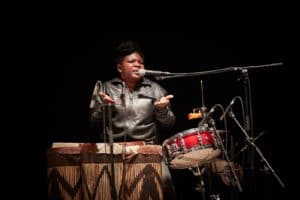
The audience, eager to surrender to the music, sometimes forgoes the need to clap and cannot help but do its own part. But each subsequent song also offers the opportunity to change tack. Like most of Linyekula's performances, it is also Not Another Diva made so that it can be played just as well in the townships, as in the Muziekgebouw or the Cultural Educational Centre in the Bijlmer. That, too, is an important choice.
Congo
At Congo, another new work by Linyekula that is also undoubtedly among the highlights of the festival, actor Daddy Moanda Kamono, singer Pasco Losanganya and now dancer and singer Linyekula focus on the cruel absurdity of the Berlin Colonial Conference and the taking of what was called Congo there.
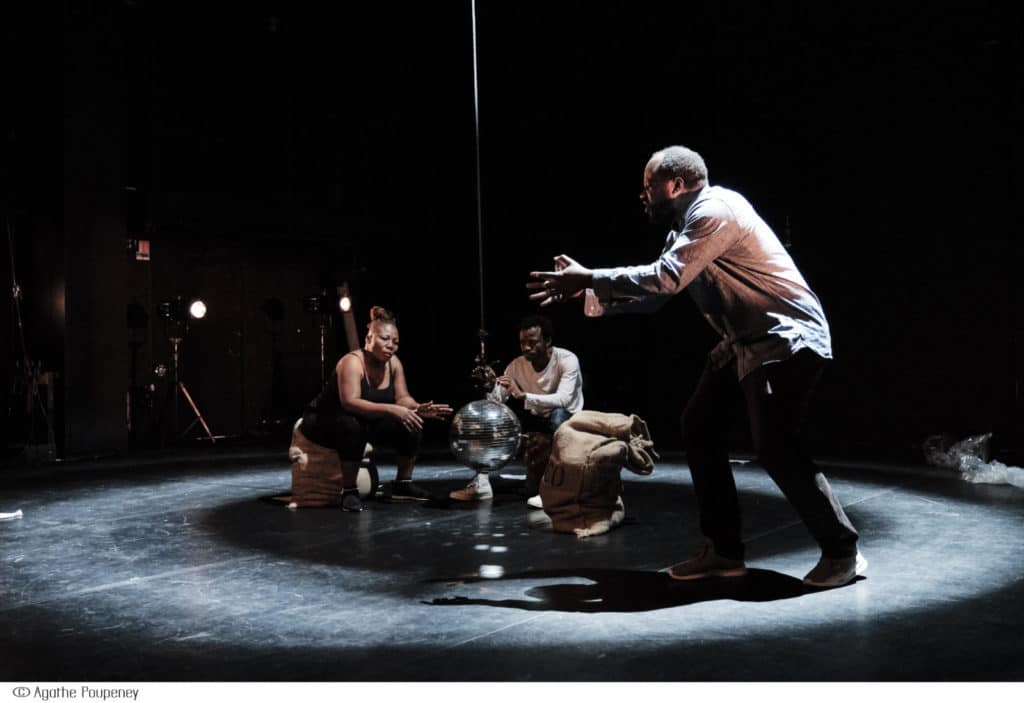
Moanda Kamono exhausts himself in intimate and detailed descriptions of the gathering of men of standing, who divide the dough in long conferences, dining and conversing under chandeliers, like a band of robbers with political legitimacy. "Look", says the actor right under Princess Beatrix's nose in row six at Theatre Frascati, "how the European powers gather here", to continue with a reflection on the table as a Western cultural asset par excellence. The second part of the show concentrates on the actual expedition into the immense new land, retelling the Belgian-flagged, exploitation and ruin from the western perspective, government officials Lemaire and Fiévez and Leopold's adventurer and adviser Henry Morton Stanley.
Large images
Vuillard's beautiful, literary texts are counterbalanced by grandiose images, with Moanda Kamono's urgent voice traversed by the bodies and singing voices of Losanganya and Linyekula. Her body is dismembered with white paint and made of Belgium, he dances a trembling death dance, his hands trembling and his arms raised and held in countless ways, eternally searching, like the countless dead who cannot find rest. The three of them circle the middle of the floor, laughing sardonically at the 'experts' from Europe, but in the end all that is left is anger and vacant amazement.
Small goats
The voices of little goats resound, as Linyekula ventures into an image of destruction. Where a simple disco ball previously depicted the riches of the earth (looted and looted again) and the beauty of the Congolese night, the stage is now filled with theatre smoke and soft red light. Countless times, the dancer drops onto the burlap bags, which the three have been lugging with them throughout the performance. Linyekula takes the time to depict the victors' perspectives at length and then break them down. Three Congolese performers are on stage as human beings. They play no role other than that of witness, of narrator, of questioning individual.
Open space
Instead of dramatic (anti-)heroes, Linyekula's work features researchers and poets, people who tell stories and ask questions from a personal position. Still Lushaba discharges her role as a mediator, the one who gives voice and casts out devils, protests and gives a sharp shape to her protest. But like the other musicians, she could retreat to the edge of the circle at any moment and leave the floor to someone else. It is reminiscent of Claude Leford's saying about democracy, that the seat of power, the centre should always be empty, belongs to no one, because basically anyone can take a seat there.
Retreating to one's own position, distancing oneself and conveying one's own perspective, is essential, as one of the other Congolese choreographers, Djino Alola Sabin, said in his interview with Culture Press. To break free from the all-consuming grand narrative of the coloniser and his heirs, corrupt regimes and fumbling NGOs, Linyekula organises open spaces in the chaos, which centuries of colonisation have produced, in his performances, as well as outside with Studios Kabako in Kisangani. They offer players and spectators a certain security, to postpone fluky judgement and defences, so that complicating facts, serious recriminations, conflicting feelings and hard-to-bridge differences in position and perspective can be shared.
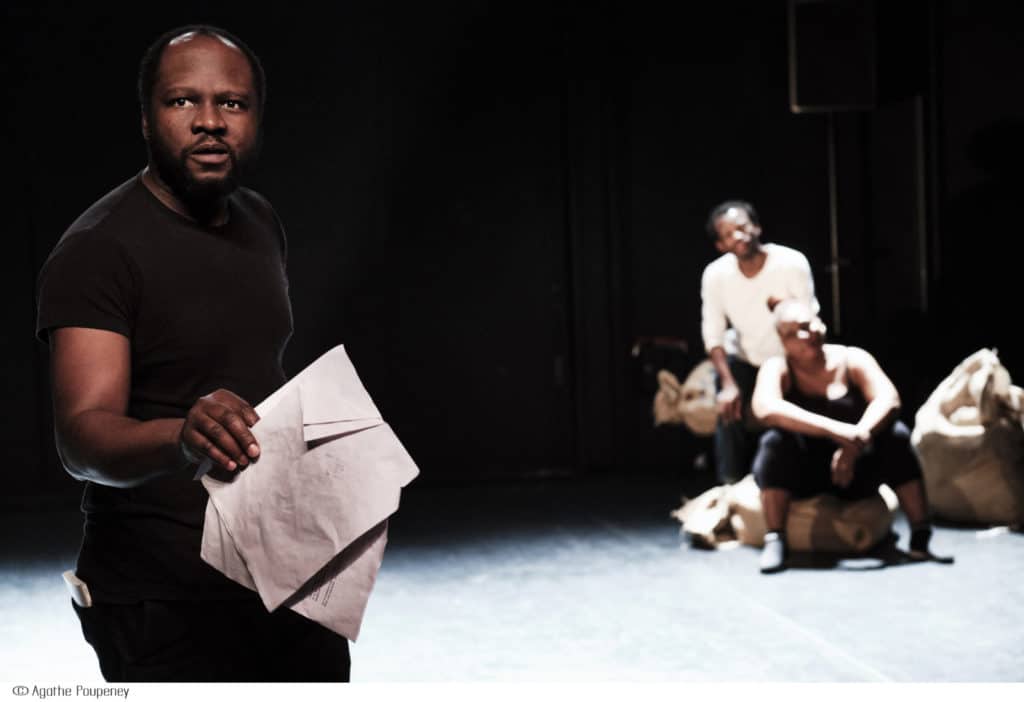
No catfish
Brecht's old adage, that the actor never coincides with his role, but shows with amazement how separate characteristics of a person contradict each other, takes on a whole new form with Linyekula. Who is actually telling whose story?
It is no cakewalk to tell new stories that are actually very old, but were bluntly kept out of the picture. They have to manage to break a radical silence, gigantic denial and deep fear of being addressed.
A matter of practice
At the same time, it is also a matter of practice, as not only Linyekula's work but also Anthony and Cleopatra by Tiago Rodrigues proved. The choreographer couple Sofia Dias and Vitor Roriz asked Rodrigues to write a text, while indicating in advance that they did not want to play a role. Rodrigues translated Shakespeare's drama into a highly indirect form of dialogue, focusing on carefully observing the other person's actions.
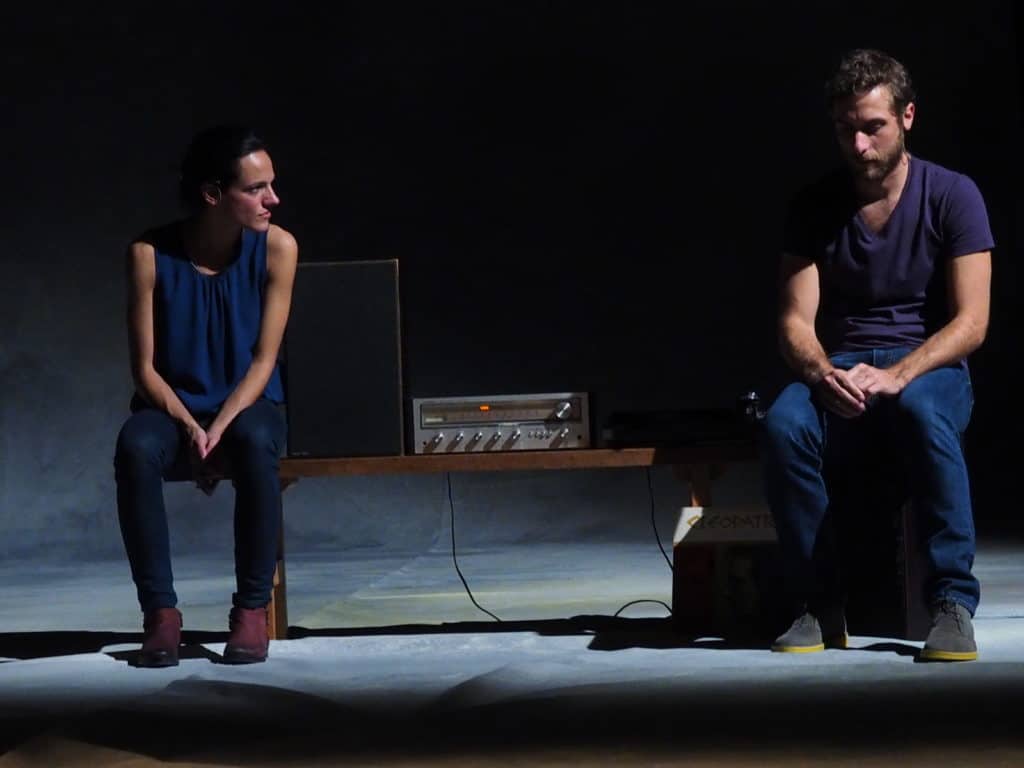
A play with language, perspective and embodiment - for most of the performance, the actors name the gestures, thoughts and feelings of the other in the third person - makes the obviousness of identities, of mine and thine, of appearing in each other's gaze, relative and provisional. Watching and being watched, naming and being named, becomes a matter of crossing more or less evenly. In the timing, the coincidence or otherwise of words and things, looks and actions, a precarious intimacy emerges.
Instead of tragic self-loss, of yearning lovers and ambitious politicians who let themselves go and end up empty-handed, the show instead revolves around the wondrous self-awareness that comes from allowing each other to feel and (re)recognise very precisely.
Colonisation is not a relationship, Linyekula said during the interview along with William Kentridge by Quinsi Gario at the beginning of the festival. Re-establishing that relationship is of great importance, for all parties, and it becomes clear during this exceptional Holland Festival edition, that theatre can play a big part in that.
